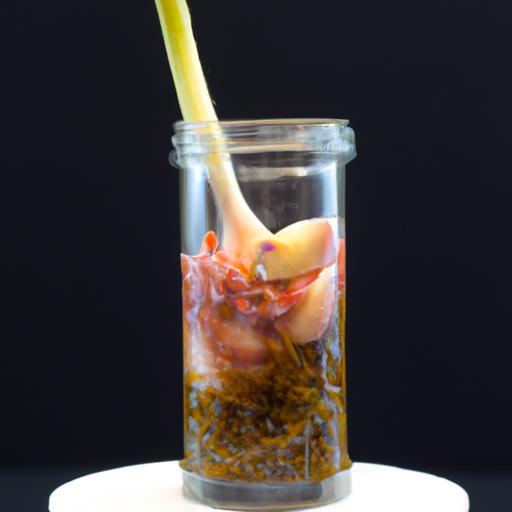In the enchanting world of fermentation, where bubbles dance and flavors transform, the humble airlock stands as the unsung hero of perfect preservation. This small yet mighty device bridges the gap between science and artistry, allowing your brews, pickles, and kombuchas to flourish in an oxygen-free sanctuary. Mastering airlocks is not just about preventing contamination-it’s about orchestrating the delicate balance of gases that breathe life into your ferment. Whether you’re a curious beginner or a seasoned fermenter, unlock the secrets behind airlock use with our top tips, and watch your culinary creations rise to their full, flavorful potential.
Unlocking the Potential of Airlocks in Fermentation
Mastering airlocks is the starting point for achieving delectable, perfectly fermented delights that dance on your palate. Whether you’re crafting tangy sauerkraut, bubbling kombucha, or your favorite sourdough starter, the airlock is your gateway to a controlled environment where wild yeasts and bacteria thrive while keeping unwanted oxygen and contaminants at bay.
Prep and Cook Time
- Preparation: 10 minutes
- Installation and Setup: 15 minutes
- Fermentation duration: Varies (1 day to several weeks)
Yield
Effective fermentation for batches ranging from 1 to 5 gallons, depending on your vessel size.
Difficulty Level
Easy to Medium – Perfect for beginners investing in their first ferment or enthusiasts upgrading their setup.
Ingredients & Tools for Your Airlock Setup
- Fermentation vessel (e.g., glass jar, ceramic crock, or food-grade plastic) with a stopper or lid compatible with airlock insertion
- Airlock types: Three-piece bubbler, S-shaped, or twin bubble airlock (choose based on your ferment’s needs)
- Water or sanitizer solution to fill the airlock chamber
- Rubber grommet or silicone sealant for snug fitting (if required)
- Sanitizing supplies to clean airlocks before use
Instructions
- Choose Your Airlock Type: Select from the common S-shaped airlock, the three-piece bubbler, or the twin bubble airlock. Each functions as a one-way valve, but the three-piece design is easiest to clean, while the S-shaped is iconic and simple. Consider your fermentation style and vessel compatibility when deciding.
- Clean and Sanitize: Rinse your airlock and accessories thoroughly with hot, soapy water. Then, sanitize using a no-rinse sanitizer or boiling water to eliminate any unwanted bacteria that could spoil your ferment.
- Fill with Water or Sanitizing Solution: Pour clean, chlorine-free water into the airlock until it reaches the fill line (usually about a third full). This water acts as a barrier, allowing gases to escape but preventing oxygen or airborne contaminants from entering.
- Prepare the Vessel: Insert the rubber grommet or ensure a tight seal on your fermentation vessel’s stopper or lid. A tight seal is paramount to prevent air leaks, which could disrupt microbial activity.
- Install the Airlock: Insert the airlock firmly into the stopper or lid hole. Double-check that it fits snugly and is set upright so bubbles can escape smoothly without splashing or drying out.
- Begin Your Fermentation: Place your prepared ferment inside the vessel and cover with the airlock-equipped lid. Store it in a temperature-stable, dark area to get those beautiful bubbling motions that indicate fermentation is alive and well.
- Monitor the Bubbles: Watch for steady bubbling, which shows active fermentation. However, lack of bubbles isn’t always failure-some ferments produce less gas. Use smell, taste, and pH tests alongside airlock monitoring.
- Troubleshoot Regularly: If bubbling stops abruptly or if water escapes from the airlock, inspect seals and water levels. Refill water to maintain the barrier. Occasionally, ferment pressure buildup may require loosening the airlock briefly.
Chef’s Notes: Tips for Success
- Variation Tips: For long-term ferments, consider replacing the water in your airlock every 5-7 days to prevent mold growth or drying out.
- Substitution Advice: If water is unavailable or risky (due to climate or contaminants), sanitized vegetable oil can be used in some airlock types to form a sterile barrier.
- Common Issue Fixes: Leaks or Off-Gassing: Ensure seals are tight and not cracked. For stubborn leaks, a small dab of food-grade silicone grease can improve airlock seating.
- Make-Ahead Instruction: Assemble and sanitize your airlock and lid the day before fermenting to streamline your process and minimize exposure when starting your batch.
- Visual Cue: Always check your airlock water level and cleanliness visually; cloudy or discolored water suggests immediate cleaning or replacement.
Serving Suggestions
While airlocks aren’t edible, your perfectly fermented creations will be! Present your ferments in clear glass jars to showcase the rich colors and textures born from proper fermentation. Garnish dishes with fresh herbs or a sprinkle of spices that complement the flavor profiles developed during fermentation-for example, dill with sauerkraut or ginger with kimchi.
Pair your batch with artisanal breads, vibrant salads, or as bold condiments enhancing grilled proteins. Use your knowledge of mastering airlocks to ensure every jar opens with the promise of vibrant fizz and tantalizing tang.
| Airlock Type | Ease of Cleaning | Best For | Price Range |
|---|---|---|---|
| S-Shaped | Moderate | Small-batch ferments, beginners | $5-$10 |
| Three-Piece Bubblers | Easy | Long-term and large batches | $7-$15 |
| Twin Bubble | Moderate | Visual fermentation monitoring | $6-$12 |
For further insights into fermentation science and techniques, visit the Cultures for Health Fermentation Guide. Explore more on how these airlock choices intersect with fermentation vessels in our guide to fermentation vessels.

Q&A
Q&A: Mastering Airlocks – Top Tips for Perfect Fermentation
Q1: What exactly is an airlock, and why is it essential for fermentation?
A1: Think of an airlock as your fermentation’s personal bouncer-it lets carbon dioxide escape but keeps unwelcome oxygen and contaminants out. This delicate balance is crucial because it creates an anaerobic (oxygen-free) environment that promotes the growth of good bacteria or yeast while preventing spoilage.
Q2: How do I choose the right type of airlock for my fermentation project?
A2: Airlocks come in various designs-3-piece, S-shaped, and bubble airlocks being the most popular. The choice depends on your comfort level and the style of fermentation. A 3-piece airlock is easy to clean and reliable, while an S-shaped one is simpler but harder to sanitize thoroughly. Bubble airlocks are great for beginners due to their straightforward design.
Q3: How much water or liquid should I put in the airlock?
A3: Fill the airlock’s chamber about halfway with filtered water or a sanitizing solution. This liquid barrier is the gatekeeper preventing contaminants from sneaking in. Avoid overfilling, as too much liquid can cause backflow, and too little can let oxygen slip through.
Q4: My fermentation isn’t bubbling-does that mean something’s wrong?
A4: Not necessarily! Bubbling is a sign of active fermentation, but slower fermentations or those at cooler temperatures might bubble less visibly. Patience is key. If fermentation stalls for more than a week, double-check your environment and ingredients for any issues.
Q5: Can I reuse airlock water from previous fermentations?
A5: It’s best to use fresh water or a freshly prepared sanitizing liquid each time. Reusing old water can introduce unwanted bacteria or contaminants, risking your batch.
Q6: How do I keep my airlock clean and sanitary?
A6: After each fermentation, disassemble your airlock and soak it in hot water with a mild sanitizer or vinegar solution. Rinse thoroughly and let it air dry. Clean airlocks maintain their integrity and prevent funky flavors or infections.
Q7: What are some common mistakes to avoid when using airlocks?
A7: Avoid letting the water in the airlock dry out-this breaks the seal and invites oxygen in. Also, don’t forcefully shake or disturb your ferment while the airlock is in place, as this can lead to spills or breakage. Lastly, ensure the airlock fits snugly to prevent leaks.
Q8: Can I ferment without an airlock?
A8: You can, but it’s riskier. Some fermenters use breathable cloth covers to allow gases out while keeping contaminants at bay, but this method exposes the batch to oxygen, which can alter flavors and increase spoilage risk. Airlocks offer a safer, more controlled environment.
Q9: How do I handle pressure buildup in a sealed fermenter with an airlock?
A9: Airlocks are designed to vent excess CO₂ safely. However, if you notice fermentation is excessively vigorous and bubbles aren’t escaping fast enough, gently release pressure by loosening the airlock or shaking lightly (away from your face) to avoid messy blowouts.
Q10: What’s the ultimate secret to mastering airlocks for perfect fermentation?
A10: Be observant and patient. The airlock is your fermentation’s silent partner-trust its signals and maintain its barrier. Combine that with clean equipment, quality ingredients, and consistent temperatures, and you’ll be well on your way to fermentation greatness!
Wrapping Up
As the bubbles rise and the airlock hums its gentle song, you’ll know that mastering fermentation is as much an art as it is a science. With these top tips in hand, you’re not just harnessing the power of an airlock-you’re becoming a conductor in the symphony of transformation, guiding your brews from humble beginnings to perfectly crafted finishes. Remember, patience and precision pave the path to that ideal ferment, where every sip tells a story of careful control and creative passion. So, tie on your apron, trust your airlock, and let the magic of fermentation unfold-one exquisite batch at a time.


